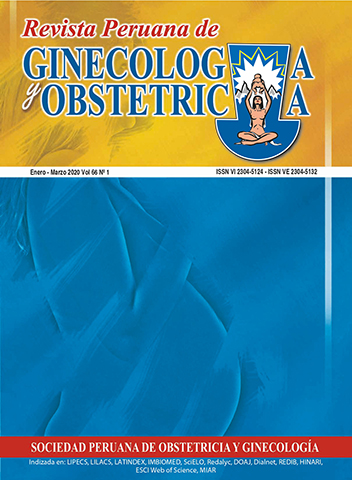Placenta accreta spectrum, experience in a Peruvian hospital
DOI:
https://doi.org/10.31403/rpgo.v66i2226Abstract
Introduction: Placenta accreta spectrum (PAS) refers to pathological adhesions of the placenta to the uterus. It is considered a public health problem due to its increase in recent decades, and it is associated with significant maternal morbidity and mortality and high risk of hemorrhage, blood transfusions and hysterectomy. Objective: To determine the epidemiological, surgical and post-surgical characteristics of patients with placenta accreta. Methods: Descriptive, retrospective study of patients with placenta accreta spectrum attended at San Bartolomé Hospital, Lima, Peru, between 2014 and 2018. Results: Thirty-six PAS cases were documented with a birth rate of 1.2/1 000; 94% occurred in multiparous women, 81% had previous uterine surgery including 26 (72%) with previous cesarean section; 61% were 35 years old or older, and 47% had placenta previa. Treatment was conservative in 53% of the cases, while hysterectomy was performed in 47%. There were post-surgical complications in 53%, without maternal deaths. Conclusions: In our study, placenta accreta spectrum was predominantly associated with previous cesarean sections. A considerable number of cases presented hemorrhage and hypovolemic shock. Timely surgical intervention and a well-supplied blood bank allowed conservative management in focal accretism as a valid alternative to hysterectomy and its complications.Downloads
Download data is not yet available.
Downloads
Published
2020-02-03
How to Cite
Ramírez Cabrera, J. O., Zapata Díaz, B. M., Díaz Lajo, V. H., Catari Soto, K. D., & Flores Valverde, M. (2020). Placenta accreta spectrum, experience in a Peruvian hospital. The Peruvian Journal of Gynecology and Obstetrics, 66(1), 13–18. https://doi.org/10.31403/rpgo.v66i2226
Issue
Section
Artículos Originales
















